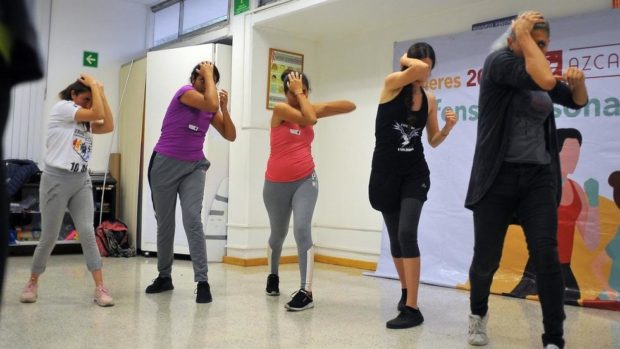In Mexico, Women Take Matters into Their Own Fists
Elena’s husband had strangled and beaten her, but it was the moment he slammed one of their twin baby girls against the bed that she decided she had to get out.
That was eight years ago.
She thought she and her daughters had escaped from danger until she got a message on her cell phone recently about strange men prowling outside their school.
The message brought her traumatic memories of violence and helplessness rushing back. It also convinced Elena, a slight single mom of 39, that it was time to take matters into her own hands again.
Or rather, her own fists: she signed herself and her daughters up for self-defense classes for women and girls offered by the government of her hometown, Mexico City — the capital of one of the most dangerous countries in the world to be a woman.
Mexico has the most femicides of any country in Latin America, according to Amnesty International.
The country was one of the first in the world to recognize femicide as a specific crime, which it did in 2007.
But that has failed to stop rampant violence against women.
More than nine are murdered in the country every day, according to UN Women.
Brains Over Brawn
Elena — whose name has been changed for her protection — knows what it means to live in the middle of this crisis.
She still remembers the sensation of her estranged husband strangling her during an argument.
“He grabbed my neck. He was suffocating me.
He pushed me against the wall while one of the babies was watching. I was terrified thinking that he could hurt my daughters,” she told AFP.
Then came the incident that prompted her to leave.
“He took one of my daughters and threw her against the bed. She was just a baby, defenseless,” she said through sobs.
Now, she and her daughters are learning to defend themselves in a university classroom in Azcapotzalco, a neighborhood on the sprawling capital’s north side.
Launched this year, the women-only self-defense courses have drawn participants from all walks of life: mothers trying to protect themselves and their children, students afraid to walk alone at night, commuters fed up with harassment on public transportation.
“Sometimes we women think we don’t have the physical strength to escape from an attack.
But I’ve learned here that it all depends how you react,” Elena said, this time speaking in a steely voice.
“As they say, brains are better than brawn.”
Bags, Umbrellas as Weapons
Beatriz Camacho, a 50-year-old teacher, signed up for the courses to learn to protect herself on the subway.
She had been groped several times.
“The last time, I kicked my attacker all the way out of the train and handed him over to the policeman on duty at the station,” said Camacho, a tall, striking woman fond of make-up and plunging necklines.
The Azcapotzalco district has offered five of the free, six-week self-defense courses in the past six months. Several other Mexico City districts are doing the same.
Students learn boxing and martial arts from Sabina, a young transsexual woman with punk style and no shortage of ways to turn bags, umbrellas or body parts into weapons.
“These workshops are about giving women tools and techniques to protect themselves,” said Ana Viveros, head of the district’s gender equality program.
Glitter Revolution
The level of violence against women in Mexico is staggering.
Two in three Mexican women say they have been victims in some form, according to the national statistics institute.
International attention has often focused on the most horrific flashpoints such as Ciudad Juarez, on the US border, where rights groups estimate more than 1,500 women were raped, killed and dumped in the desert, or simply disappeared without a trace, in the 1990s.
But cosmopolitan Mexico City is not exempt.
The capital has been swept by protests this year over rampant violence against women, triggered by several notorious cases, including that of a 17-year-old girl who was allegedly raped by four police officers inside their patrol car in Azcapotzalco.
The movement is now known as the “Glitter Revolution,” after protesters doused the capital’s security minister in pink glitter at one demonstration.
Related Articles
Activists are pushing Mayor Claudia Sheinbaum — the first woman elected to lead Mexico City — to declare a “gender violence alert” in the capital of nine million people.
Declaring an alert would require the local government to earmark funds to tackle the problem, deploy additional security, launch a task force and implement other emergency measures.
Seventeen of Mexico’s 32 states have declared such alerts since 2007.
“Mexico needs to accept that we live in a profoundly patriarchal culture of machismo, where men think women are the property of their fathers, brothers, bosses, partners,” said Tania Reneaum Panszi, executive director of Amnesty International’s Mexico office.
It will take a deep cultural shift to change that, she said.
Brenda Carmona, a 24-year-old design student, let out a deep breath as she finished training at Sabina’s class.
“The unfortunate thing is that feeling unsafe is the norm,” she said.
“I just wish they would respect us. I just wish we didn’t have to live in fear.”


